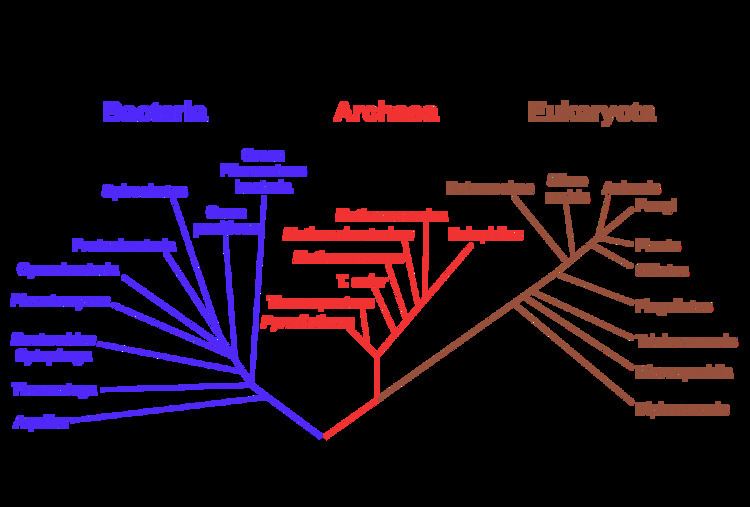 | ||
In biological taxonomy, a domain (Latin: regio) is the highest taxonomic rank of organisms in the three-domain system of taxonomy designed by Carl Woese, an American microbiologist and biophysicist. According to the Woese system, introduced in 1990, the tree of life (biology) consists of three domains: Archaea (a term which Woese created), Bacteria, and Eukarya. The first two are all prokaryotic microorganisms, or single-celled organisms whose cells have no nucleus. All life that has a nucleus and membrane-bound organelles, and multicellular organisms, is included in the Eukarya. Stefan Luketa in 2012 proposed the five-domain system of life with both cellular and non-cellular organisms.
Contents
Domain or dominion
The term "domain" is proposed by Woese et al. (1990) in his three-domain system. This term represents a synonym for the category of dominion (lat. dominium), introduced by Moore in 1974. However, only S. Luketa uses the term dominion.
Characteristics of the three domains of life
Each of these three domains of life recognized by biologists today contain unique rRNA. This fact in itself forms the basis of the three-domain system. While the presence of a nuclear membrane differentiates the Eukarya domain from the Archaea and Bacteria domains, both of which lack a nuclear membrane, distinct biochemical and RNA markers differentiate the Archaea and Bacteria domains from each other.
Archaea
Archaea are prokaryotic cells, typically characterized by membrane lipids that are branched hydrocarbon chains attached to glycerol by ether linkages. The presence of these ether linkages in Archaea adds to their ability to withstand extreme temperatures and highly acidic conditions, but many archea live in mild environments. Halophiles, organisms that thrive in highly salty environments, and hyperthermophiles, organisms that thrive in extremely hot environments, are examples of Archaea. Archaea evolved many cell sizes, but all are relatively small. Their size ranges from 0.1 to 15 μ diameter and up to 200 μ long. They are about the size of bacteria or similar to the size of a mitochondrion in a eukaryotic cell. Members of the genus Thermoplasma are the smallest of the archaea.
Bacteria
Even though bacteria are prokaryotic cells just like Archaea, their membranes are made of unbranched fatty acid chains attached to glycerol by ester linkages. Cyanobacteria and mycoplasmas are two examples of bacteria. They characteristically do not have ether linkages like Archaea, and they are grouped into a different category—and hence a different domain. There is a great deal of diversity in this domain, and between that and horizontal gene transfer, it is next to impossible to determine how many species of bacteria exist on the planet.
Eukarya
Organisms in the domain Eukarya are eukaryotic cells, or consist of them, which have membranes that are similar to those of bacteria. Eukaryotes are further grouped into Kingdom Fungi (yeast, mold, etc.), Kingdom Plantae (flowering plants, ferns, etc.) and Kingdom Animalia (insects, vertebrates, etc.) and the now-defunct, paraphyletic Kingdom Protista (algae, protozoans, etc.).
Not all Eukaryotes have a cell wall, and even the walls of those that do don't contain peptidoglycan, which bacteria do have. While cells are organized into tissues in the kingdom Plantae as well as the kingdom Animalia, cell walls are never found in animal cells.
Exclusion of viruses
None of the three systems currently include non-cellular life. As of 2011 there is talk about Nucleocytoplasmic large DNA viruses possibly being a fourth branch domain of life, a view supported by researchers in 2012.
Stefan Luketa in 2012 proposed a five-domain system, adding Prionobiota (acellular and without nucleic acid) and Virusobiota (acellular but with nucleic acid) to the traditional three domains.
Alternative classifications
Alternative classifications of life so far proposed include:
